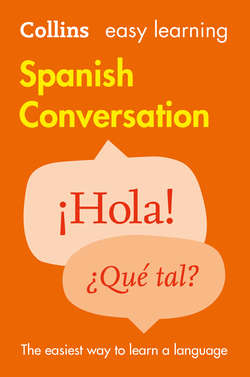Читать книгу Easy Learning Spanish Conversation - Collins Dictionaries - Страница 102
LISTEN OUT FOR
ОглавлениеHere are some key phrases you are likely to be given when you are travelling around.
| El tren de Cáceres sale de la vía tres. | The train for Cáceres is leaving from platform three. |
| ¿Puedo ver su billete? | Can I see your ticket? |
| ¿Le importa que me siente aquí? | Do you mind if I sit here? |
| Es mejor que coja un taxi. | You’d be better getting a taxi. |
| Cuando llegue a la plaza pregunte allí. | Ask again when you get to the square. |
| Siga recto hasta el semáforo. | Go straight on till you get to the traffic lights. |
| Coja la primera calle a la derecha. | Take the first turning on the right. |
| Gire a la izquierda. | Turn left. |
| Está muy cerca. | It’s very near. |
| Está enfrente del museo. | It’s opposite the museum. |
| Se puede ir andando. | It’s within walking distance. |
| Está a tres paradas de aquí. | It’s three stops from here. |
Lifestyle Tips
• Spaniards are expected to carry identity cards at all times, so they take it for granted that anyone might need to prove their identity. Be prepared to present your passport when checking into a campsite or going to a hotel. You may be asked: ¿Su carnet? (Your ID card, please) or ¿Su pasaporte? (Your passport, please). As you’ll need to carry your passport with you, don’t forget to keep it in a safe place.
• If you’re in charge of a car, be ready to produce your driving licence if asked for it by the police. If you’ve left it behind, you may well be fined. The police officer might ask you: ¿Me deja ver su carnet de conducir? (Can I see your driving licence?).
• When planning your journey, remember that in Spain autopistas (motorways) are often toll motorways. Every so often you will come to a peaje (toll barrier) where you will be required either to take a ticket or to hand over some money. When paying, you’ll need to choose a lane marked manual if you haven’t got the exact change or you aren’t paying by card. Otherwise, you can go into an automático lane. Nowadays, there are also Telepeaje (teletoll) lanes identified by a sign showing a white T on a blue background. These are for cars fitted with a chip allowing journeys to be tracked and paid for automatically.
• Queues tend to be informal in Spanish-speaking countries. So if you’re at the bus stop or trying to get to an information desk and don’t know who’s last in line, just ask ¿Quién es el último? (Who’s last in the queue?).
• If there’s no timetable at the bus stop, you can ask people waiting if they’ve seen your bus go past. Just ask ¿Ha pasado el número 33? (Has the number 33 been yet?).
